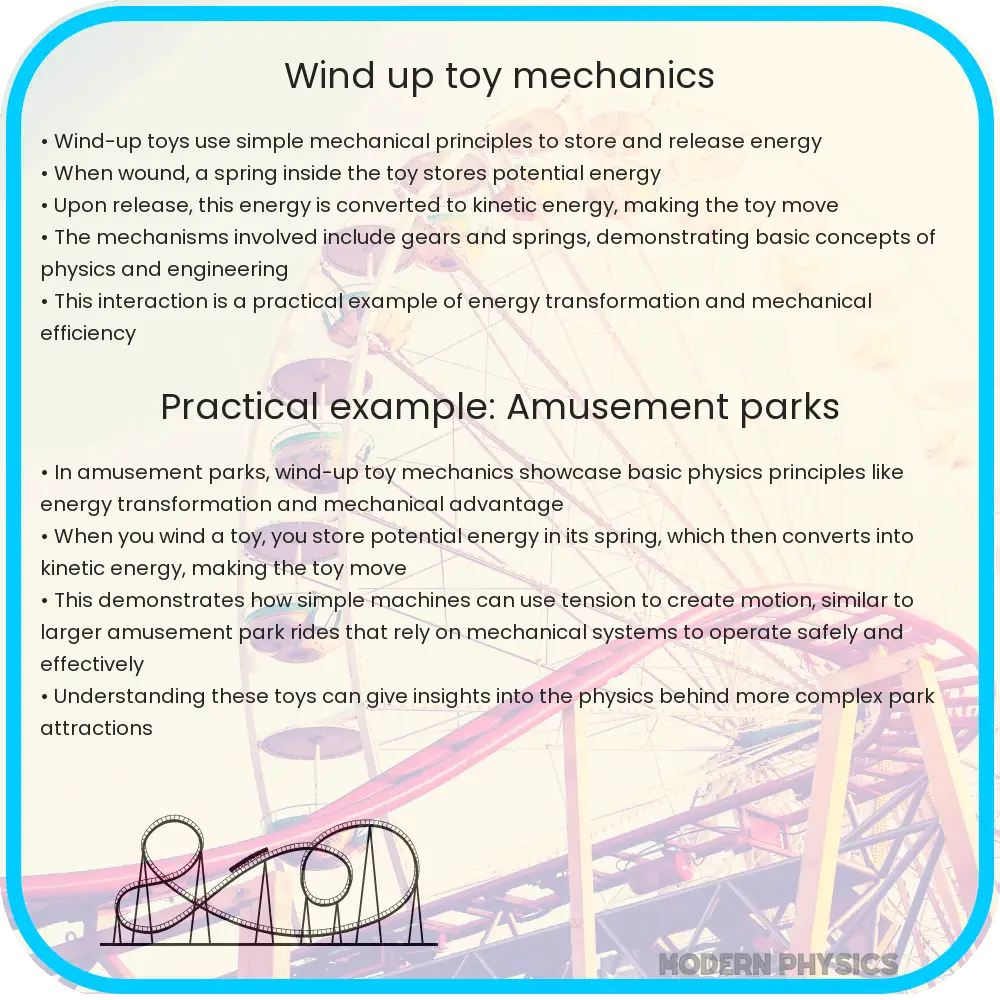Explore the fascinating mechanics of wind-up toys, uncovering the principles of dynamics, motion, and forces in this insightful article.

Exploring the Mechanics of Wind-Up Toys: An Insight into Dynamics, Motion, and Forces
Wind-up toys, a staple of childhood for generations, offer more than just entertainment. These fascinating devices are a playground for understanding basic principles of mechanics and physics. In this exploration, we delve into the dynamics, motion, and forces at play within the simple yet intriguing world of wind-up toys.
The Inner Workings of Wind-Up Toys
At the heart of a wind-up toy’s functionality is the spring mechanism. When the toy is wound up, the spring inside is twisted, storing potential energy. This energy type, denoted as elastic potential energy, is given by the equation \( E_p = \frac{1}{2}kx^2 \), where \( E_p \) represents the elastic potential energy, \( k \) is the spring constant, and \( x \) is the displacement of the spring from its equilibrium position.
Converting Potential to Kinetic Energy
As the spring unwinds, the stored potential energy is converted into kinetic energy, propelling the toy forward. The law of conservation of energy dictates that the total energy in a closed system remains constant. Thus, the initial potential energy in the wound-up spring is transformed into the kinetic energy of motion, following the equation \( E_k = \frac{1}{2}mv^2 \), where \( E_k \) is the kinetic energy, \( m \) is the mass of the toy, and \( v \) is its velocity.
Understanding Motion and Forces
The motion of wind-up toys is governed by Newton’s laws of motion. Primarily, Newton’s first law, often referred to as the law of inertia, plays a key role. It states that an object will remain at rest or in uniform motion in a straight line unless acted upon by an external force. In the case of wind-up toys, the external force is the release of energy from the spring mechanism.
Furthermore, the frictional force between the toy and the surface it moves on is crucial. This force acts in the opposite direction of motion, gradually slowing the toy down. The magnitude of this force can be calculated using the formula \( F_f = \mu F_n \), where \( F_f \) is the frictional force, \( \mu \) is the coefficient of friction, and \( F_n \) is the normal force exerted by the surface.
In conclusion, wind-up toys are not just playful trinkets but are embodiments of fundamental mechanical principles. Through their simple design, they vividly illustrate how potential energy is stored, transformed, and ultimately utilized to create motion, governed by the unyielding laws of physics.
Delving Deeper: The Role of Gears and Levers in Wind-Up Toys
Another critical aspect of wind-up toy mechanics involves the intricate use of gears and levers. Gears in these toys are designed to regulate the release of energy from the spring, ensuring a smooth and sustained movement. The interlocking teeth of gears translate rotational motion into linear motion, a principle known as mechanical advantage. This mechanism allows wind-up toys to utilize the stored energy efficiently, maximizing their motion duration.
The Impact of Materials and Design
The choice of materials in the construction of wind-up toys significantly affects their performance. Lighter materials, such as plastic, reduce the overall mass \( m \) in the kinetic energy equation \( E_k = \frac{1}{2}mv^2 \), allowing for quicker acceleration. Conversely, heavier materials can store more energy but may require more force to initiate movement. The design, including the shape and distribution of mass, also plays a vital role in how efficiently the toy can convert and utilize its stored energy.
Exploring Limitations and Efficiency
Despite their simplicity, wind-up toys are not perfectly efficient systems. Energy losses primarily occur due to friction and air resistance. Friction not only occurs between the toy and the surface but also within the internal mechanisms like gears and springs. Air resistance, although minimal for smaller toys, can still impact the toy’s speed and distance traveled.
Concluding Thoughts: The Timeless Appeal of Wind-Up Toys
In conclusion, wind-up toys are more than mere playthings. They are miniature marvels of mechanical engineering, encapsulating fundamental principles of dynamics, motion, and forces. Through their simple yet effective design, these toys demonstrate the transformation of potential energy into kinetic energy, the role of forces and motion, and the impact of material and design on mechanical efficiency. They not only entertain but also educate, providing a hands-on experience of physics at work. As we advance in the age of technology, wind-up toys remain a testament to the beauty of basic mechanical principles, continuing to fascinate and inspire curiosity in both young minds and the young at heart.
Whether for educational purposes or nostalgic enjoyment, the charm of wind-up toys endures, bridging generations and continuing to spin the wheels of imagination and inquiry into the fundamental laws of physics.
